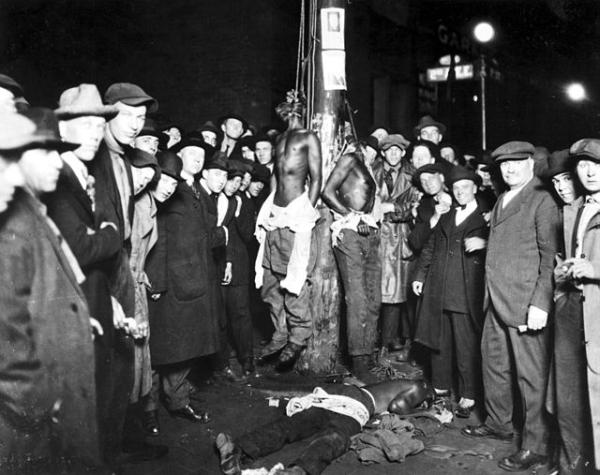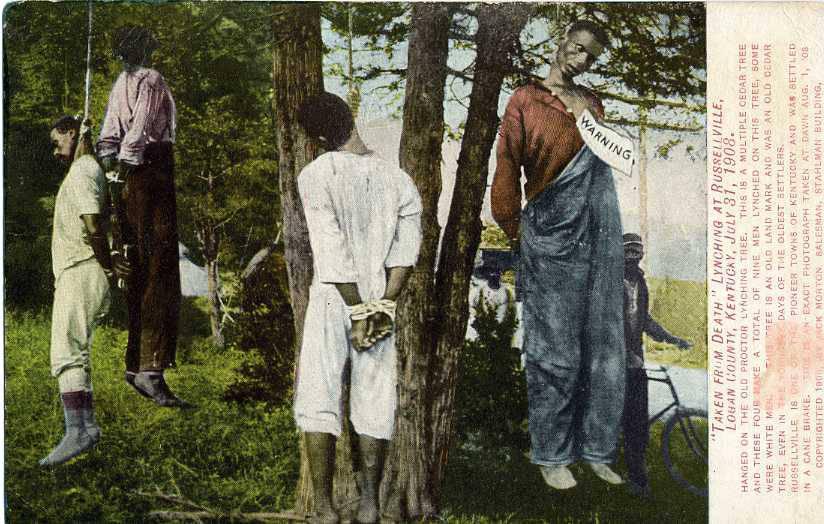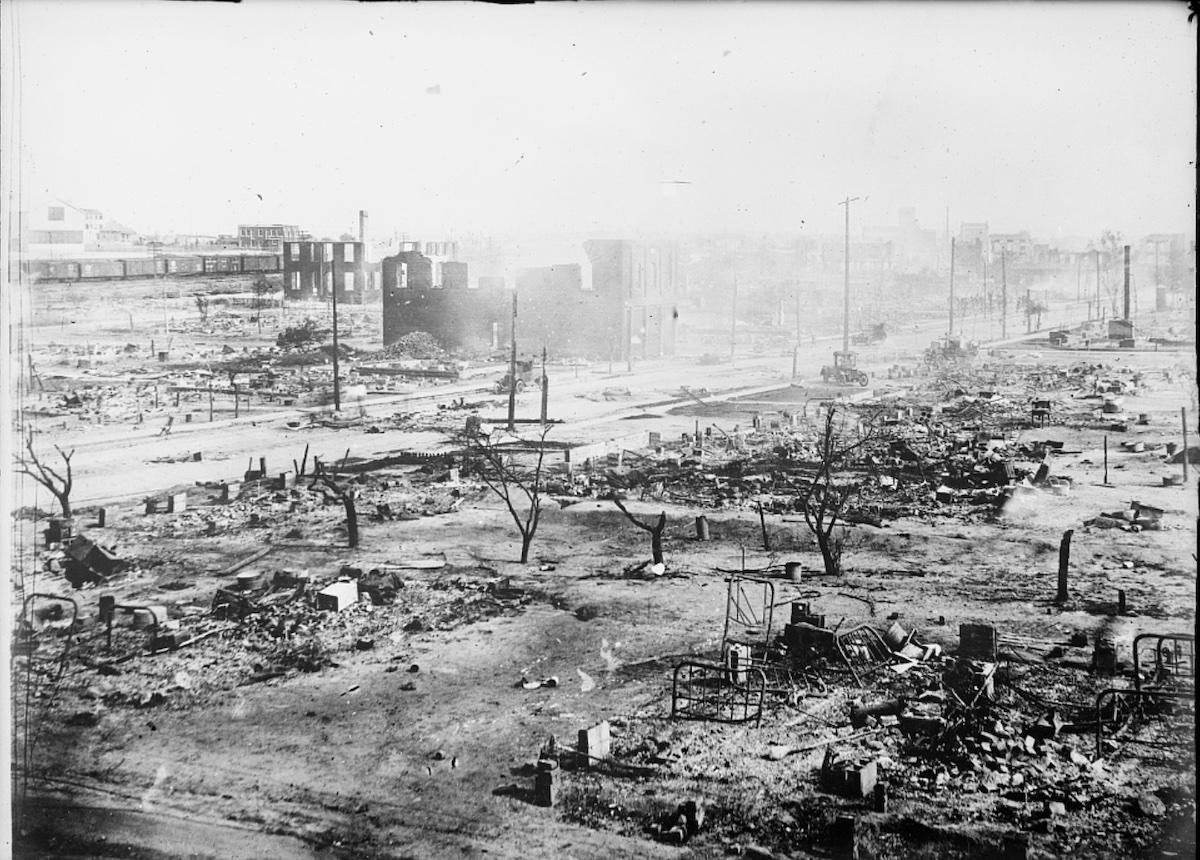Bob Avakian has written that one of three things that has “to happen in order for there to be real and lasting change for the better: People have to fully confront the actual history of this country and its role in the world up to today, and the terrible consequences of this.” (See “3 Things that have to happen in order for there to be real and lasting change for the better.”)
In that light, and in that spirit, “American Crime” is a regular feature of revcom.us. Each installment focuses on one of the 100 worst crimes committed by the U.S. rulers—out of countless bloody crimes they have carried out against people around the world, from the founding of the U.S. to the present day.
See all the articles in this series.

June 15, 1920, Duluth, Minnesota: three Black men lynched for the alleged rape of Irene Tuskin, a white woman, while a crowd of thousands watched. Photo: Wikipedia
THE CRIME:
For over 100 years, from the Civil War period into the 1950s and beyond, thousands of Black people have been lynched in America. Lynchings are violent, public acts of torture, often mutilation, and murder, carried out by white people to terrorize and traumatize Black people. They are lawless actions, often carried out in broad daylight, with thousands taking part and none of the lynchers getting arrested or punished. Cops and government officials often took part.1
When people think of lynching, they think of people being hung from trees or poles. This was part of what took place, but lynchings were also carried out by beating or torturing Black people to death, or shooting them down. Innocent people were even lynched by being burned alive, dragged behind cars, or thrown off bridges.
Black men, women, and children were lynched—sometimes whole families. Sometimes hundreds were massacred and whole towns or neighborhoods destroyed. A few examples:
Tulsa, Oklahoma. In 1921, the Greenwood District of North Tulsa was a self-sufficient, relatively prosperous Black neighborhood known as “Black Wall Street.” On May 31, after false rumors of a Black man assaulting a white woman were spread, an armed lynch mob of some 500, including 150 Tulsa police, attacked Greenwood. At least 75 armed Black men, including military veterans, heroically tried to defend their neighborhood. But by the next day more than 300 Black people had been massacred, and 40 square blocks of Greenwood burned to the ground, destroying 1,256 homes, businesses, schools, churches, and other buildings. Not one of these heinous criminal acts have ever been prosecuted or punished by the city, county, state, or federal government.2
Elaine, Arkansas. On the night of September 30, 1919, Black sharecroppers were organizing against the bitter poverty they were forced to live and work in. White landowners found out about their efforts and unleashed a lynch mob which massacred at least 200 Black people, perhaps many more. Afterward, some 300 Black people were arrested, but not a single white person was ever arrested or prosecuted.3
Rosewood was a small, self-sufficient Black town in rural Florida. During the first week of January 1923, a white lynch mob attacked and destroyed the town. At least six Black people were killed, but eyewitnesses claim the death toll was much higher, anywhere from 27 to 150.4
Most of those who were lynched were never accused of or charged with any crime. They could be murdered because someone said they assaulted a white person, or approached or just whistled at a white woman. Black people were lynched for demanding basic rights and fair treatment. Many were murdered for minor violations of “Southern manners”—manners which demanded Black people always act like they were totally beneath white people:
- In 1940, Jesse Thornton was lynched in Luverne, Alabama, for referring to a white police officer by his name without the title of “mister.”
- In 1918, Private Charles Lewis was lynched in Hickman, Kentucky, after he refused to empty his pockets while wearing his Army uniform.
- Richard Wilkerson was lynched in Manchester, Tennessee, in 1934 for allegedly slapping a white man who had assaulted a Black woman at an African American dance.
- White men lynched Jeff Brown in 1916 in Cedarbluff, Mississippi, for accidentally bumping into a white girl as he ran to catch a train.
- In 1917, Sam Gates was lynched for the offense of “annoying white girls” in England, Arkansas.
Lynching Carnivals

A colorized postcard of the lynching of Virgil Jones, Robert Jones, Thomas Jones, and Joseph Riley on July 31, 1908, in Russellville, Kentucky. Credit: Public domain (Wikipedia)
These were not secret acts, but part of public life in the South. Sometimes thousands, and sometimes virtually the whole white community, would attend pre-announced lynchings. These were often day-long celebrations with a carnival atmosphere. Families came with picnic baskets, vendors sold food, and photographers documented the occasion—selling pictures of the lynching as postcards. Sometimes the victim’s body parts were sold as “souvenirs.” Here’s one example:
In 1904, after Luther Holbert allegedly killed a local white landowner, he and a Black woman believed to be his wife were captured by a mob and taken to Doddsville, Mississippi, to be lynched before hundreds of white spectators. Both victims were tied to a tree and forced to hold out their hands while members of the mob methodically chopped off their fingers and distributed them as souvenirs. Next, their ears were cut off. Mr. Holbert was then beaten so severely that his skull was fractured and one of his eyes was left hanging from its socket. Members of the mob used a large corkscrew to bore holes into the victims’ bodies and pull out large chunks of “quivering flesh,” after which both victims were thrown onto a raging fire and burned. The white men, women, and children present watched the horrific murders while enjoying deviled eggs, lemonade, and whiskey in a picnic-like atmosphere.
Lynchings were so widespread that Southern white children played it as a game. It was called “Salisbury,” probably named for a series of lynchings in Salisbury, North Carolina, in 1902 and 1906.5
The Equal Justice Initiative found that there were 4,084 racial terror lynchings in 12 southern states between the end of Reconstruction in 1877 and 1950, and another 300 in other states.6
Campaign of Mass Terror with Lasting Impact to this Day
All Black people, especially in the South, lived under the threat of lynchings—for the smallest excuse or for no excuse at all. This traumatized and terrorized all Black people.
The great author Richard Wright was born in Mississippi and knew of two men who were lynched—his step-uncle and the brother of a neighborhood friend. In his book Black Boy, Wright wrote:
The things that influenced my conduct as a Negro did not have to happen to me directly; I needed but to hear of them to feel their full effects in the deepest layers of my consciousness. Indeed, the white brutality that I had not seen was a more effective control of my behavior than that which I knew.
THE CRIMINALS
- No branch of the U.S. government—North or South, including the courts, the legislatures, and the executive branches—at the federal, state and local levels did anything to stop the horror of lynching. Fewer than one percent of lynch mob participants were ever convicted by local courts and they were rarely prosecuted or brought to trial.
- White vigilante terror groups such as the Ku Klux Klan—KKK.
- The many thousands of white people who took part in lynchings, celebrated them, or remained silent in the face of them.
- Northern academics who promoted bogus “scientific” theories that Black people were inferior to whites—which some continue to do to this day.
- The U.S. Congress, which refused to pass any laws against lynching until 2021 (!), despite the fact that bills outlawing lynching had been introduced as far back as 1900.
- Leading U.S. officials, including U.S. presidents, who openly promoted racism and white supremacy. For example:
- In his 1867 annual message to Congress, President Andrew Johnson declared that Black Americans had “less capacity for government than any other race of people,” that they would “relapse into barbarism” if left to their own devices, and that giving them the vote would result in “a tyranny such as this continent has never yet witnessed.”
- In 1897, Rebecca Latimer Felton, the wife and campaign manager of a U.S. Congressman, argued that one of the great problems in American society was that men were not providing adequate attention to “white women’s vulnerability to the Black rapists” who were supposedly roaming the rural South. “The fault, she declared, lay with southern white men. They had failed to put a ‘sheltering arm about innocence and virtue.’” She concluded that “if lynching was required ‘to protect women’s dearest possession from the ravening human beasts—then I say lynch, a thousand times a week, if necessary.’”7
- In 1906, President Theodore Roosevelt declared that “the greatest existing cause of lynching is the perpetration, especially by Black men, of the hideous crime of rape.”
- In 1915, President Woodrow Wilson, a Democrat, hosted a showing of the white-supremacist, pro-Confederate film Birth of a Nation in the White House. He praised the film, saying “this was like writing history with lightning.” It was the first film ever to be shown in the White House. His family, his Cabinet and the filmmaker D.W. Griffith attended.
THE ALIBIS
The main excuses white mobs used to justify lynching were claims that Black men had approached or sexually assaulted white women or that they had committed some crime—from murder to trivial offenses. Black people were lynched because they’d stepped out of their “place” under the thumb of white people by demanding basic rights, speaking out against mistreatment, or failing to totally subordinate themselves to white people, such as not stepping off the sidewalk to let white people pass or even looking white people in the eye. And many Black people were lynched for no reason at all other than being in the wrong place at the wrong time.
Lynchings were more formally justified by government and the media as necessary to control supposedly lawless Black people. As a 1905 investigative report put it:
Lynching has been resorted to by whites not merely to wreak vengeance, but to terrorize and restrain this lawless element (sic) in the Negro population. Among Southern people, the conviction is general that terror is the only restraining influence that can be brought to bear upon vicious Negroes.
We won't comment on the bitter irony here that many white men routinely raped Black women and were almost never legally punished. Or that the accusation of lawlessness was being made by the very people who were engaged in horribly sadistic mob violence against people who had never been found guilty in a court of law!
THE MOTIVES
Why did the U.S. ruling class, as a whole, support lynching? Because shortly after the Civil War, the capitalist system in the U.S. made a leap to a new stage—to a worldwide system of imperialism, which divided up the entire globe among a handful of powers. The re-entrenchment of white supremacy in a new form, after the Civil War, formed an important element in the U.S. rise to major power status among these imperialists.
The cotton and tobacco produced by the bitterly exploited Black sharecroppers were the top cash crops of the U.S. from 1850 to 1890, and Black men who were arrested by Southern sheriffs on the flimsiest of charges and literally sold as slave labor built the industrial infrastructure of the South.
Lynching played a very important role in all this, and the U.S. ruling class backed them to the hilt. Sometimes lynchings were carried out for greed—to murder Black people and steal their land. (The Associated Press documented over 57 violent land-takings by whites.)
But the hellish social function served by lynchings was larger than this. Lynchings served to enforce the social and economic system in which Black people were chained to the land through terror, which played a crucial role in the functioning and strength of U.S. capitalism, and its rise as a global imperialist power.8
Bob Avakian, "They're selling postcards of the hanging," clip from Revolution: Why It's Necessary, Why It's Possible, What It's All About, a film of a talk by Bob Avakian, a film of a talk.

